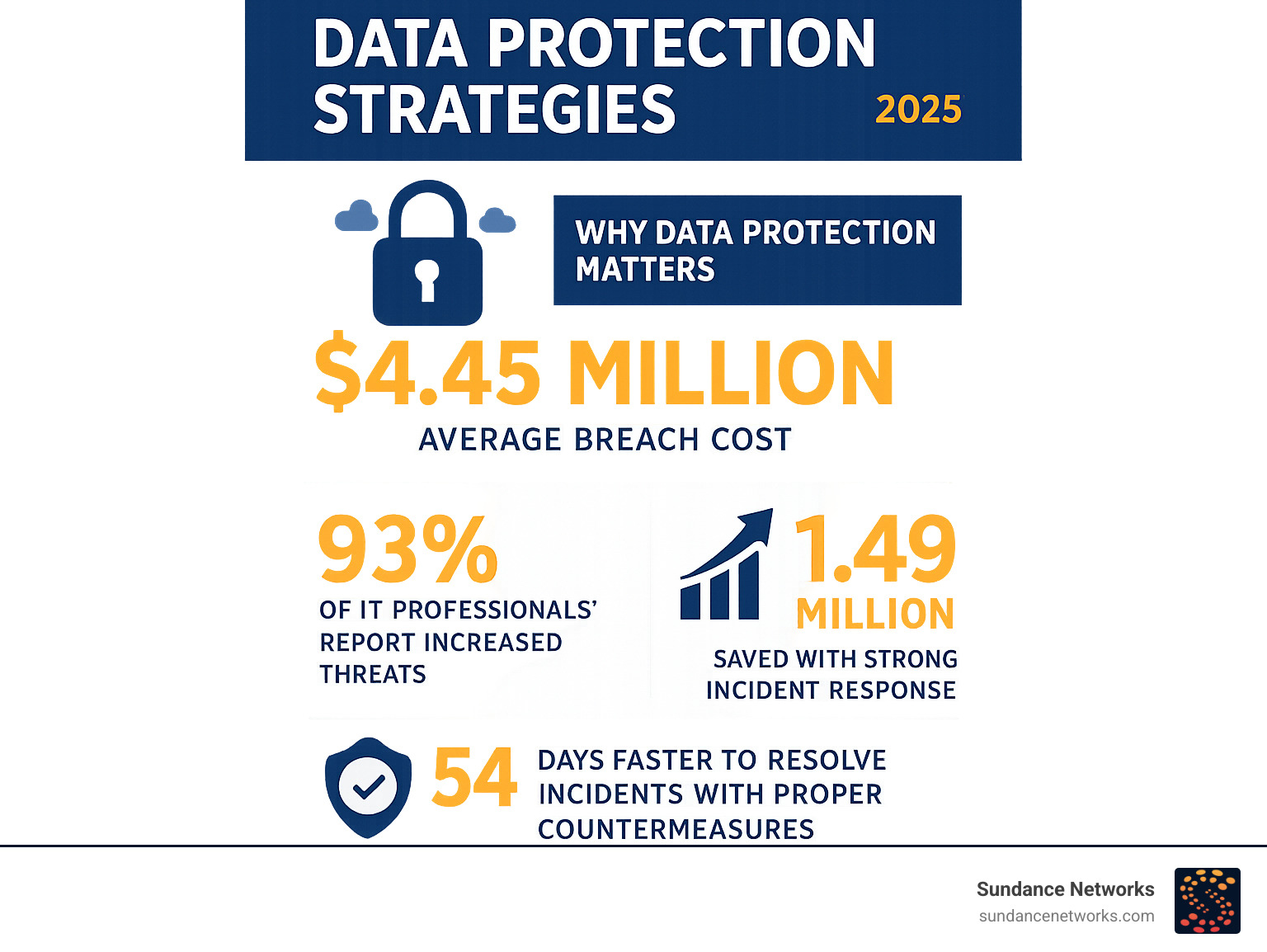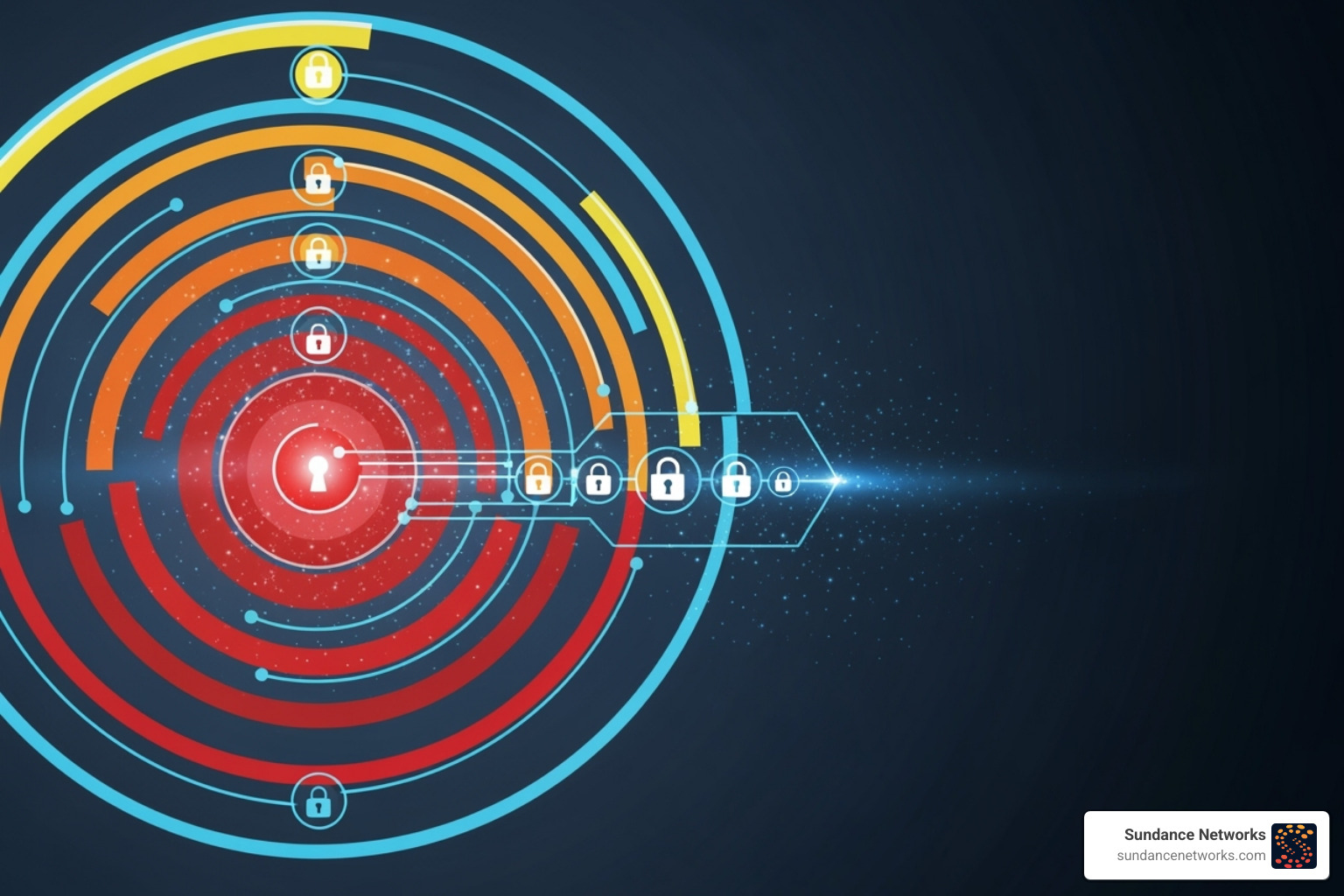
Data protection strategies are comprehensive frameworks that safeguard your organization’s sensitive information from unauthorized access, breaches, and loss. In today’s digital landscape, these strategies aren’t optional—they’re essential for business survival.
Essential Components of Data Protection Strategies:
- Data Findy & Classification – Know what data you have and its sensitivity level
- Access Controls – Limit who can access sensitive information using multi-factor authentication
- Encryption – Protect data both at rest and in transit with strong encryption protocols
- Backup & Recovery – Implement the 3-2-1 backup rule for business continuity
- Incident Response – Have a plan ready for when breaches occur
- Compliance Management – Meet regulatory requirements like GDPR, HIPAA, and CCPA
The stakes couldn’t be higher. The global average cost of a data breach reached $4.45 million in 2023—a 15% increase over three years. Organizations with strong incident response measures saved $1.49 million compared to those without proper protections.
But it’s not just about money. Data breaches destroy customer trust, damage your reputation, and can result in massive regulatory fines. GDPR violations alone can cost up to 4% of your annual global turnover or €20 million, whichever is higher.
The threat landscape is evolving rapidly. 93% of IT professionals believe security threats are increasing in volume or severity—a dramatic jump from 47% just one year earlier. Ransomware attacks surged by 27%, with some companies forced to pay ransoms to recover their data.
The good news? Organizations that take a proactive approach see real results. Companies with high levels of incident response countermeasures resolve security incidents 54 days faster than those without proper measures.
Your data protection strategy isn’t just about preventing disasters—it’s about building a competitive advantage through trust, reliability, and operational resilience.

The Core Components of Effective Data Protection Strategies
Effective data protection strategies are built like a house: with a solid foundation and integrated systems. Each component is vital for safeguarding your organization’s most valuable asset. Let’s break down these essential building blocks to make the process manageable.
Step 1: Data Findy, Classification, and Lifecycle Management
You can’t protect what you don’t know you have. The first step is creating a data inventory, a comprehensive map of all information in your organization. This means knowing what data you have, where it lives, and how it moves.
Next, data classification organizes data into categories like public, internal, confidential, and restricted. This ensures that more sensitive information receives higher levels of protection. Data mapping then visualizes the data’s journey from creation to deletion, a process known as Data Lifecycle Management.
With threats on the rise, this intimate knowledge of your data is critical for identifying your “crown jewels”—the information most vital to your business. Many organizations now use AI-powered tools to automate and improve the accuracy of this process.
Step 2: Implement Strong Access Controls

Once you know your data, you must control who can access it. Strong access controls act as a gatekeeper for your sensitive information.
The Principle of Least Privilege is the core concept: give users the minimum access required for their jobs. This drastically reduces risk if an account is compromised.
- Role-Based Access Control (RBAC) simplifies permissions by assigning access levels to roles, not individuals.
- Multi-Factor Authentication (MFA) adds a critical security layer, requiring a second verification factor beyond a password.
- Zero Trust architecture assumes no user or device is inherently trustworthy, requiring verification for every access request.
- Identity and Access Management (IAM) systems centralize control over user access across all applications and systems.
For organizations looking to integrate these robust access controls, our Custom IT Consulting & System Integration services can help design a solution that fits your specific needs.
Step 3: Encrypt Data at Rest and in Transit
Data encryption converts information into a coded format that only authorized users can read, making it unreadable to attackers. It’s a last line of defense that protects data even if other security measures fail.
- Data at rest is information in storage (servers, laptops, cloud). Encrypting it is like locking valuables in a safe.
- Data in transit is information moving across networks (emails, file transfers). Encrypting it is like using an armored car for transport.
Effective encryption key management is also critical. Keys must be stored and managed securely, separate from the data they protect. Understanding both symmetric (single key, fast) and asymmetric (two keys, secure for communication) encryption helps in applying the right method for the right situation.
Step 4: Establish Robust Backup and Disaster Recovery Plans

Disasters—from hardware failure to cyberattacks—can happen at any time. A robust backup and disaster recovery plan is essential for business survival.
The 3-2-1 backup rule is a core best practice: maintain three copies of your data on two different media types, with one copy stored off-site or in the cloud. This strategy provides strong protection against data loss, including from ransomware.
Crucially, backup testing is non-negotiable. Regularly test your backups to ensure they are complete and can be restored successfully. You must also define your:
- Recovery Time Objective (RTO): How quickly you need to be back online after a disaster.
- Recovery Point Objective (RPO): The maximum amount of data you can afford to lose.
These elements form a business continuity plan that keeps critical functions running. Regular, tested backups are your insurance against the unexpected. Our Disaster Recovery & Backup services can help you build a comprehensive plan that fits your specific recovery needs.
Step 5: Develop a Proactive Incident Response Plan
Security incidents are a matter of ‘when,’ not ‘if.’ A proactive incident response plan is what separates prepared organizations from those that falter. The key phases include:
- Threat Detection: Continuously monitor systems to spot incidents early and minimize damage.
- Containment: Isolate affected systems to prevent the threat from spreading.
- Eradication: Remove the root cause of the incident and any malicious elements.
- Recovery: Restore systems and data using your backup and disaster recovery plans.
- Post-Incident Analysis: Learn from the event to strengthen future defenses.
A clear communication plan for stakeholders is also vital to manage your reputation. Organizations with strong incident response plans save an average of $1.49 million per breach and resolve incidents 54 days faster. Our Cyber Security Services can help you build and refine incident response capabilities that work when you need them most.
Step 6: Ensure Regulatory and Compliance Adherence
Compliance with data protection regulations is no longer just about avoiding fines; it’s about building customer trust. The regulatory landscape is complex and constantly evolving.
Key regulations include:
- GDPR: The EU’s General Data Protection Regulation, with fines up to 4% of annual global turnover.
- HIPAA: Protects patient health information in the US.
- CCPA: Grants California consumers rights over their personal data.
- PCI DSS: Sets security standards for handling credit card information.
Organizations must also consider data sovereignty (laws based on where data is stored) and conduct Data Protection Impact Assessments (DPIAs) for high-risk processing activities. With Gartner predicting 75% of the world’s population will be covered by privacy regulations by 2024, staying compliant requires continuous adaptation. Our Regulatory Compliance Services help you steer this complex landscape and adhere to the law.
Data Protection vs. Data Privacy vs. Data Security: Understanding the Crucial Differences
The terms “data protection,” “data privacy,” and “data security” are often used interchangeably, but they represent distinct concepts. Understanding them is crucial for building effective data protection strategies. Think of them as three interlocking gears, each vital to the whole system.

- Data Security: This is the technical foundation. It uses tools like firewalls, encryption, and access controls to protect data from unauthorized access or alteration. It’s built on the CIA Triad: Confidentiality, Integrity, and Availability.
- Data Privacy: This focuses on individual rights. It governs how personal information is collected, used, and shared, emphasizing consent, transparency, and user control. It asks why and what data is being handled.
- Data Protection: This is the comprehensive umbrella strategy. It encompasses both data security and data privacy, along with regulatory compliance and lifecycle management, to create a holistic framework for responsible data handling.
Here’s how they compare:
| Attribute | Data Protection | Data Privacy | Data Security |
|---|---|---|---|
| Goal | Safeguard data integrity, availability, and confidentiality; ensure compliance and ethical handling | Protect individual rights regarding their personal data; ensure consent and control | Protect data from unauthorized access, alteration, or destruction |
| Scope | Holistic: encompasses security, privacy, compliance, and lifecycle management | Focuses on personal data and individuals’ rights; ethical use of data | Technical safeguards for data assets across the organization |
| Methods | Policies, procedures, governance, risk management, security tools, privacy practices, audits | Consent mechanisms, anonymization, data minimization, transparency, user rights management | Encryption, access controls, firewalls, intrusion detection, backups, incident response |
These three concepts work in tandem. Strong security enables privacy, and both are essential components of a complete data protection strategy. Understanding these distinctions helps create more effective policies and ensures all bases are covered.
Best Practices for Implementing and Maintaining Your Strategy
A data protection strategy is not a one-time project; it’s a living process. Like a garden, it requires constant care and adaptation to evolve with new threats, technologies, and business needs.
Conduct Regular Risk Assessments and Audits
Regular assessments are essential for maintaining your security posture. They help you find and fix weaknesses before they can be exploited.
- Vulnerability scanning automatically checks your systems for known security flaws.
- Penetration testing simulates a real-world cyberattack to test your defenses in a controlled environment.
- Third-party risk management evaluates the security of vendors and partners who have access to your data.
- A security gaps analysis compares your current controls against industry best practices to identify areas for improvement.
Regular assessments help you stay ahead of breaches and strengthen your cybersecurity posture. For a thorough evaluation of your current security stance, consider our Cybersecurity Scan.
Foster a Culture of Security with Employee Training
Your employees can be your strongest defense or your biggest vulnerability. Since human error is a leading cause of breaches, continuous training is essential to foster a culture of security.
Key training areas include:
- Phishing simulations to test and improve your team’s ability to spot malicious emails.
- Password hygiene education on creating strong, unique passwords.
- Secure data handling procedures for storing, accessing, and sharing sensitive information.
- Social engineering awareness to recognize manipulation tactics.
- Clear reporting procedures so employees know how to report suspicious activity quickly.
Investing in your people’s security awareness is one of the most effective ways to protect your organization.
Continuously Monitor and Evolve Your Approach
The cybersecurity landscape is constantly changing, so your protection strategies must evolve too. Continuous monitoring is key to staying ahead.
- Security Information and Event Management (SIEM) systems act as a central command center, analyzing logs from across your IT environment to detect threats.
- Log monitoring provides the detailed records needed to spot unusual activity, like failed logins or strange data access patterns.
- Adapting to new threats means staying informed on the latest attack methods through threat intelligence and industry forums.
- AI-driven security offers proactive risk management by detecting subtle anomalies that traditional methods might miss, especially in complex cloud environments.
Continuous monitoring and adaptation are essential for keeping your defenses effective. Our AI Solutions can provide the advanced capabilities needed for this vigilance.
Frequently Asked Questions about Data Protection Strategies
How do I start building data protection strategies if I have a limited budget?
Effective data protection doesn’t require a massive budget. Start smart by prioritizing your efforts.
- Conduct a risk assessment: Identify your most critical data and focus your resources there first.
- Implement foundational controls: Low-cost, high-impact measures like Multi-Factor Authentication (MFA) and the 3-2-1 backup rule are essential.
- Leverage open-source tools: Use free options for firewalls, antivirus, and vulnerability scanning to establish a baseline of security.
- Focus on policies and training: Employee training and clear security policies are cost-effective ways to prevent human error, a leading cause of breaches.
Start with what you can, and build from there. Some protection is always better than none.
How often should a data protection strategy be reviewed?
A protection strategy is a living document that requires regular reviews to remain effective. You should review it:
- At least annually: A comprehensive annual review keeps your strategy aligned with business goals, threats, and regulations.
- After a security incident: Use any breach or near-miss as a learning opportunity to strengthen your defenses.
- Following major technology changes: New software, cloud migrations, or BYOD policies introduce new risks that must be addressed.
- When new regulations are introduced: Update your strategy to ensure compliance with evolving legal requirements.
Proactive, regular reviews are key to keeping your defenses sharp.
What is the single most important element of a data protection strategy?
There is no single most important element. An effective data protection strategy is a holistic approach that integrates technology, processes, and people.
However, if one component is often overlooked, it’s a well-trained and security-aware workforce. Technology can’t stop every threat, and human error is a major factor in breaches. Educated employees who can spot phishing attempts, handle data securely, and report suspicious activity transform your biggest potential vulnerability into your strongest line of defense.
True security comes from integrating all components—from technical controls to employee training—into a comprehensive, adaptive framework.
Secure Your Future with a Proactive Data Protection Strategy
Your data is one of your most valuable assets. Effective data protection policies are not just about preventing disaster; they build a competitive advantage through trust, reliability, and resilience.
Success requires a holistic approach that combines key components: data classification, access controls, encryption, backups, incident response, and regulatory compliance. By integrating technology, processes, and a security-aware culture, you transform your strategy from a static document into a living defense system.
The results are clear: proactive organizations save an average of $1.49 million per breach and resolve incidents 54 days faster. Most importantly, they protect the customer trust that is essential for long-term success.
At Sundance Networks, we understand that while every business is unique, the need for robust data protection is universal. From our locations in Santa Fe and Stroudsburg, we’ve helped countless organizations build layered defenses and foster a culture of continuous improvement.
Don’t wait for a breach to happen. The time to act is now. Your customers, employees, and future success depend on a strong foundation of security and trust.
Take the next step toward securing your organization’s future. Get a comprehensive security assessment with our Managed Services and Security and find out how strong your defenses really are. Be ready when threats come.


